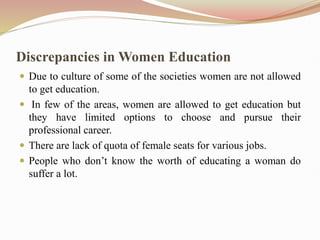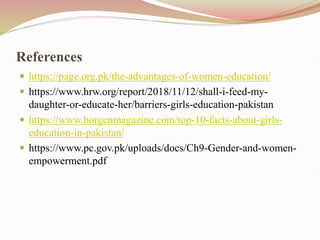Women Education in Pakistan at different levels.pptx
- 1. Rubab Batool Government College Women University Faisalabad
- 3. Introduction The word Education means “the process of imparting knowledge, skills and judgment between right and wrong”. In this age, education is one important tool to differentiate amongst human beings and animals. It doesn’t only teach us the skills, imparting knowledge but also addresses that how we can live in society which is diverse.
- 4. Women Education Education is important for both men and women. But Women Education! This word might give a sense of education to women but it actually means “Education to a Nation ‘’, as it is commonly said: Educating a woman is like educating the entire family. According to the A-37, constitution of the Pakistan education is the fundamental right of every female citizen.
- 5. Discrepancies in Women Education Due to culture of some of the societies women are not allowed to get education. In few of the areas, women are allowed to get education but they have limited options to choose and pursue their professional career. There are lack of quota of female seats for various jobs. People who don’t know the worth of educating a woman do suffer a lot.
- 6. Social Benefits of Women Education Education enhances a woman’s (and her partner and the family’s) level of health as it enhances her level of awareness regarding a healthy lifestyle. A woman has a lot of things to manage but only if she is educated. She can manage their domestic affairs properly. She can grooms her child and helps them by putting in proper way towards learning or getting education. Education can help a woman to participate in political and social sciences to raise their voices to get their rights.
- 7. Economic Benefits of Women Education Empirical studies have revealed that increase in women’s education boosts their wages and that returns to education for women are frequently larger than that of men. Increase in the level of female education improves human development outcomes such as child survival, health and schooling. Developmental Economists argue that in developing countries female education reduces fertility, infant mortality and increases children’s education. Gender inequality in education directly and significantly affects economic growth.
- 8. Gender Inequality in Pakistan Thirty-two percent of primary school age girls are out of school in Pakistan, compared to 21 percent of boys. By grade six, 59 percent of girls are out of school, versus 49 percent of boys. Only 13 percent of girls are still in school by ninth grade. Both boys and girls are missing out on education in unacceptable numbers, but girls are worst affected.
- 9. Gender Disparity through out the Country In Balochistan, the province with the lowest percentage of educated women, as of 2014-15, 81 percent of women had not completed primary school, compared to 52 percent of men. Seventy-five percent of women had never attended school at all, compared to 40 percent of men. Khyber Pakhtunkhwa had higher rates of education but similarly huge gender disparities. Sindh and Punjab had higher rates of education and somewhat lower gender disparities, but the gender disparities were still 14 to 21 percent.
- 10. Problems faced by Women High rate of maternal mortality. Violence against women and girls, including rape “honor” killings and violence, acid attacks, domestic violence forced marriage and child marriage All of these issues government responses are inadequate. Pakistani activists estimate that there are about 1,000 honor killings every year. Twenty-one percent of females marry as children.
- 11. Barriers to girl’s Education within School System 1. Lack of Investment Pakistan spends far less on education as recommended by the (UNESCO). Result of that there are not enough schools for all children to have access to one. 2. High Cost of Education Government schools are generally more affordable than private education, but they sometimes charge tuition, registration or exam fees, and they almost require that parents pay the associated costs. These include stationery, copies, uniforms, school bags, and shoes.
- 12. Continue 3. Poor Quality Education Quality education is so poor. Overcrowded, poor facilities and scarce amount of teachers in schools are big questions on the quality of education. In low-cost private schools, teachers are less qualified and untrained. 4. No Enforcement of Compulsory Education there is no organized effort by government in any province to ensure that all children study. When a child drops out of school, individual teachers sometimes encourage the child to continue studying, but there is no systematic government effort to enroll or retain children in school.
- 13. Continue 5. Corruption Some people simply purchase teaching positions, and others obtain their jobs through political connections. In rural areas, some schools sit empty because teacher’s salary go to someone who does not teach.
- 14. Barriers to Girls’ Education Outside the School System 1. Poverty Many children, including girls, are out of school because they are working. They are engaged in paid work Girls often consists of home based industries, such as sewing, embroidery, beading, or assembling items. Girls are kept home to do domestic works.
- 15. Continue 2. Social Norms Attitudes regarding girls’ education vary significantly across different communities. In some areas, families violating cultural norms that prohibiting girls from studying, in this case family face pressure and hostility. Girls are often removed from school as they approach puberty.
- 16. Continue 3. Insecurity insecurity, including sexual harassment, kidnapping, crime, conflict, and attacks on education. Families worry about busy roads; the large distance many girls must travel to school increases risks and fears. Many girls experienced sexual harassment on the way to school, and police demonstrate little willingness to help prevent harassment.
- 17. Continue 4. Armed Conflict and Targeted Attacks on Schools Pakistan has been targeted attacks against students, teachers, and schools. The most devastating attack on education was the December 2014 attack on the Army Public School in Peshawar city, where 145 people killed almost all of them children. Between 2013 and 2017, hundreds of schools were attacked, typically with explosive devices, killing several hundred students and teachers, and damaging and destroying infrastructure. One-third of these attacks specifically targeted girls and women, aiming to interrupt their studies.
- 18. Vision of Pakistan 2025 The Vision 2025 and prospective 11th Five Year Plan approach to provide an enabling environment and equal opportunities to women for development of their full potential to enjoy the benefits of economic growth, prosperity and social development consequent upon the outcome of the initiatives taken by the federal and provincial governments, as well as by the stakeholders. The Pakistan National Policy for Development and Empowerment 2002 ensures women equal access to all development benefits and social services.
- 19. Gender and Women Empowerment Programmes in Pakistan The government, civil society and international organizations have been designing plans to achieve gender equality and women empowerment through awareness raising campaigns and allocation of budget under their annual development programmes. Women’s participation in employment will be encouraged, and ten percent quota for women employment will be ensured by the institutions concerned.
- 20. Continue At the federal level, the Ministry of Law, Justice and Human Rights has planned to protect women from violence by establishing a helpline for legal advice. The implementation of Harassment Act will also be ensured further. The National Commission on Status of Women will analyze and review gender policies, interventions to protect their rights and will give recommendation to the government on women issues.
- 21. MDGs and SDGs Pakistan has committed to meet the MDGs, particularly Goal 3 – ‘promoting gender equality and empowering women’ – and Goal 5 – ‘improving maternal health’ – and is also a signatory of the United Nations Convention for Elimination of all forms of Discrimination against Women (UNCEDAW). There has been a shift from the MDGs to the SDGs, and a lot of efforts need to be made for achieving sustainable goals for women development.
- 22. Performance Review of MDGs 2014-15 The women development departments have been established in provinces, which have been empowered under the 18th Constitutional Amendment. These departments take initiatives for the establishment of working women hostels, day care centers, women crises centers, shelter homes, etc. National Plan of Action, Gender Reform Action Programmes, Benazir Income Support Programme (BISP), National Rural Support Programme (NRSP), Pakistan Bait-ul-Maal, First Women Development Bank and National Commission on the Status of Women.
- 23. United States Agency for International Development Provided health, legal, and counseling services to approximately 61,000 female survivors of Gender Based Violence (GBV). Awarded more than 6,600 higher education scholarships to young women in Pakistan. Supported the Federal Ministry of Human Rights to train 196 public prosecutors on laws protecting women’s rights, gender issues, and legal protections for GBV survivors. Trained and financed more than 50,000 women entrepreneurs. Facilitated national identity card registration for approximately 1.5 million women to promote women’s voting rights. Helped train almost 16,000 female political party representatives.
- 24. References https://page.org.pk/the-advantages-of-women-education/ https://www.hrw.org/report/2018/11/12/shall-i-feed-my- daughter-or-educate-her/barriers-girls-education-pakistan https://www.borgenmagazine.com/top-10-facts-about-girls- education-in-pakistan/ https://www.pc.gov.pk/uploads/docs/Ch9-Gender-and-women- empowerment.pdf























